In 1920 the Russian refugee bishops established the Russian Orthodox Church Outside of Russia (ROCOR), also known as the Russian Church Abroad. In 1927 this church renounced subordination to the Church in Russia (also known as the Moscow Patriarchate). On May 17, 2007, representatives of both churches concelebrated Divine Liturgy in the Moscow Christ Savior Cathedral. The process of reconciliation between the Moscow Patriarchate and the ROCOR became a rare example of true ecumenical dialogue, helping the two estranged branches identify common ontological grounds.
The author sketches the historical antecedents of the ROCOR’s relations with the Moscow Patriarchate and analyzes the ROCOR’s conciliar pronouncements and other representative documents from the period of estrangement. This paper demonstrates that the ROCOR ecclesiology of the studied period had been struggling to avoid the perils of isolationism. The history of the Orthodox Church teaches us that ecclesiastical divisions tend to be most persistent when one of the estranged factions believes that the separation is predicated on doctrine. Despite the ROCOR’s occasional reference to doctrinal reasons underlying the estrangement, this division was, in fact, a result of political considerations and therefore was easier to overcome than, for instance, in the case of the Old Believers.
This article is a development of a paper submitted in St. Vladimir’s Seminary for Dogmatic
Theology-413. The article was presented in an abbreviated form at the 2009 conference of Orthodox Theological Society in America, Brookline, MA and was published in Greek Orthodox Theological Review 1-4 (2007) [c] 2010.
The history of the Orthodox Church teaches us that ecclesiastical divisions tend to be most persistent when one of the estranged factions believes that the separation is predicated on doctrine. Without going many centuries back, it is sufficient to mention the controversy over the Russian Old Believers in the seventeenth century as well as the Greek Old Calendarist movement in the twentieth.
The divisions that result from what I would call “political reasons” are relatively easy to repair. By “political reasons” I refer to divisions caused by external events, such as a revolution or a change of a political regime. Even if in the course of years the separated factions try to attach putative doctrinal differences to the separation, the actual political causes of that separation make reunification much more feasible. The reunification of the homeland and diasporic branches of the Serbian Orthodox Church in 1992 is a distinctive example.
The reconciliation on May 17, 2007, of the Patriarchate of Moscow and the Russian Orthodox Church Outside of Russia (ROCOR), also known as the Russian Church Abroad, has afforded us an opportunity to study the most recent model of successful reconciliation of two ecclesiastical bodies separated by political factors. In this paper we shall examine the ecclesiological attitude of the ROCOR toward the Patriarchate of Moscow in order to see what fundamentals allowed the development of a dialogue, what elements caused complications in rapprochement, and what elements could facilitate the future of a united Russian Church.
In order to elucidate the recent perception of the Moscow Patriarchate by the Russian Church Abroad, I will briefly sketch the historical antecedents of the ROCOR’s relations with the Moscow Patriarchate. I will also analyze the ROCOR’s conciliar pronouncements and other representative documents from the 1920’s through the 1990’s.
The ecclesiological trends of the Russian Church Abroad have reflected particular historical conditions. The ecclesiology of decentralization was largely a repercussion of the Soviet attempts to control the Orthodox Church. The same tendency of decentralization, although at a more problematic level, dominated the ecclesiology of the Catacomb Church. The Moscow Patriarchate’s strategy of maintaining their central administration by means of compromise with the government led to the ROCOR perception of the bishops of Moscow Patriarchate as “enslaved.” Representatives of all Church branches looked forward to an All-Russia Council, that, as a sequel to the council of 1917-18, was to be a spiritual landmark for the Soviet period of the Russian Church.
Branch in Exile and Church in Russia 1920-1959
In 1919 the Southern Russian Church Council founded the Supreme Church Administration in the South of Russia (SCA-SR) in Stavropol. The president of the SCA-SR, Archbishop Dimitrii Abashidze of Tavrida, did not join the majority of the bishops under him when they evacuated from Krimea to Istanbul as a result of the civil war. In Istanbul, the exiled administration was led by the senior refugee hierarch, Metropolitan Antonii Khrapovitskii of Kiev and Galicia.
Following their flight from Russia, the bishops continued to consider themselves under the jurisdiction of the Church Administration based in Moscow. On November 19, 1920 [December 6 new style], the SCA-SR met aboard a ship in Istanbul Harbor. Discussions there centered on what the SCA-SR could do by way of ministering to Russian exiles given the impossibility of maintaining relations with the Supreme Church Administration in Russia (SCA-R). Thus the Supreme Church Administration Abroad was established (SCA-A).
Despite the fact that the SCA-A was established outside the bounds of the canonical territory of Patriarch Tikhon, he nonetheless blessed its activities in the Patriarchate of Constantinople. [1]Akty Sviateishego Tikhona, patriarkha Moskovskogo i vseia Rossii, pozdneishie doumenty i perepiska o kanonicheskom preemstve vyshei tserkovnoi vlasti 1917-1943, compiled by M.E. Gubonin (Moscow: … Continue reading At the same time the Russian bishops abroad considered themselves in subordination to the SCA-R. One of the documents published by the First Pan-Diaspora Council (1921) stated that the Council recognized that it was under the authority of the Patriarch of Moscow.[2]Deiania russkogo vsezagranichnogo tserkovnogo sobora (Sremski Karlovtsi: Serbian Monastery Printshop, 1922), 5. Likewise, all the decrees issued by the SCA-A began with the standard phrase, “By the blessing of His Holiness, the Patriarch of Moscow and all Russia.” Thus the members of the Russian Church Abroad did not conceive of their ecclesiastical body as being independent from Patriarch Tikhon and the ecclesiastical administration in Russia. However, the subsequent disparate realities of life in the diaspora and life in the homeland led to widely different ecclesiastical policies. On May 5, 1922, under pressure from the OGPU 6th division (Soviet secret police in charge of arresting and incarcerating Russian Orthodox clergy) [3]Sledstvennoe delo Patriarkha Tikhona: Sbornik dokumentov po materialam Tsentral’nogo Arkhiva FSB RF (Moscow: St. Tikhon’s Orthodox Humanitarian University, 2000), 118-119.,Patriarch Tikhon, along with the Holy Synod and the Supreme Church Council, issued a decree dissolving the SCA-A.
In an attempt to release Patriarch Tikhon from responsibility for émigré clergy, the ROCOR Bishops Council on September 2, 1922 dissolved the SCA-A. The same Council established the Synod of Bishops of the Russian Church Abroad, the current ecclesiastical authority, based on the Ukase No. 362 promulgated by Patriarch Tikhon, the Holy Synod and the Supreme Church Council (Oct. 20, 1920) [4]Priest Georgii Mitrofanov, Pravoslavnaia Tserkov’ v Rossii i emigratsii v 1920-e gody (S.Petersburg: Noah, 1995), 97.. This decree allowed for the decentralization of church administration in the Russian Church in the event of political upheavals.
On June 30, 1923, Patriarch Tikhon was released from prison. In various pronouncements that appeared in Soviet periodicals, he went so far as to reprimand the anti-Soviet political activity of the Russian Church Abroad. On November 12, 1925, eight months after the death of Patriarch Tikhon, the Synod of Bishops of the ROCOR recognized Metropolitan Peter Polianskii of Krutitsy as the Locum Tenens of the Patriarchal Throne.
Throughout all the years of Patriarch Tikhon’s reign, the patriarchal Church had been unable to obtain legitimate, corporate status within the framework of the Soviet system. The Soviet government granted corporate privileges only to the “Innovationist” church. Without corporate status, all dioceses and parishes of the Tikhonite Church had quasi-legal standing in the USSR and were forbidden to maintain foreign relations. Like the ancient Christian apologists, Patriarch Tikhon and his successor Metropolitan Peter tried to promote their quest for corporate rights by stating in their pronouncements that Orthodox Christians were loyal citizens of the “Soviet empire.”
Metropolitan Peter, whom Patriarch Tikhon had deputized, in turn appointed a number of clerics to serve as his own deputies. [5]This was an extraordinary measure since canons do not allowed to assign successors, and in normal circumstances a Locum Tenens is an interim position until the next Council. Only one of them, Sergii Staragorodskii, Metropolitan of Nizhnii-Novgorod from December 1925 to 1936 actually served as Metropolitan Peter’s deputy. Until his arrest in November 1926, Metropolitan Sergii ruled by consensus with the other bishops. In March 1927 he was unexpectedly released from prison. In May, Metropolitan Sergii organized a Synod of hand-chosen hierarchs, over which he presided.
According to the All-Russia Council of 1917-18, the Synod of Bishops of the Russian Church was to be elected by the local Council. The executive authority of Metropolitan Sergii’s Synod, however, derived from his own position as a Substitute to the Locum Tenens. His Synod was not simply an unofficial advisory board but an executive body registered by the state. For this project he did not ask the blessing of Metropolitan Peter, the Locum Tenens. In fact, Metropolitan Sergii was merely a substitute for the Locum Tenens and, in this position it was at least questionable whether he could undertake, on his own, projects that would have a substantial impact on the Church.
Like his predecessors, Sergii tried to lead the Russian Orthodox Church out of its legal deadlock, and on July 29, 1927, he issued his apologia (commonly known as the “Declaration”), a statement of loyalty to the Soviet government, in which he interprets the negative attitude of the Soviet government toward the Russian faithful as a direct result of the activity of Russian ecclesiastical émigrés. Metropolitan Sergii demanded from the clergy abroad a pledge of loyalty to the Soviet government. Inside the country, he excluded imprisoned clergy and laity from liturgical commemoration, but authorized commemoration of the Soviet government. He did so in marked contrast to Patriarch Tikhon who, though invested with patriarchal authority and elected by the All-Russia Council, was sensitive to the diversity of views within his church. For example, Tikhon revoked his decrees adopting the Gregorian calendar and receiving Archpriest Krasnitskii into communion, which had not met with the support of the Orthodox pleroma.
Metropolitan Sergii began to issue canonical sanctions against those bishops who, because of their unwillingness to accept this new course, separated themselves from him. Many Russian bishops considered Sergii’s stance an act of usurpation. At that time the Russian Orthodox Church had about 150 bishops inside Russia. According to conservative estimates, no less than forty of them had failed to support Metropolitan Sergii in one way or another. By 1937 five metropolitans had been deposed by Metropolitan Sergii and his Synod, [6]In Russia: Kirill Smirnov of Kazan and Iosif Petrovykh of Leningrad; in diaspora: Antonii of Kiev and Galicia, Evlogii Georgievskii of Volynia and Platon Rozhdestvenskii of Odessa. a situation without precedent in the history of the Russian Church. Reacting to this situation, the Bishops Council of the Church Abroad on September 5, 1927, resolved:
“1) The branch of the All-Russian Church located outside of Russia must cease administrative relations with the Moscow Church authority because of its enslavement to the godless Soviet power, which has deprived it of the freedom to express and to guide the Church according to the canons;
2) In order to release our hierarchy from responsibility for the part of the Russian Church located abroad had not recognized the authority of the Soviet power, until normal relations with Russia are restored and until the liberation of our Church from the persecution of the godless Soviet power, the branch of our Church located abroad should govern itself in accordance with the Holy Canons, Resolutions of the Sacred Local Council of All-Russian Orthodox Church of 1917-18 and by the decree of His Holiness Patriarch Tikhon, Holy Synod and Supreme Council from 7/20 of November 1920; by the assistance of the Bishops Synod and the Council of Bishops with the Kievan Metropolitan Antonii presiding;
3) The branch of the Russian Church abroad considers itself an indissoluble spiritually-united branch of the Great Russian Church. It has not separated itself from the Mother-Church and does not consider itself autocephalous. It still regards the Patriarchal Locum Tenens Metropolitan Peter as head of the church and commemorates his name during the services;
4) If there should be a resolution of Metropolitan Sergii and his Synod concerning the excommunication of bishops and clergy abroad who are not willing to sign a pledge of loyalty to the Soviet Government, such a resolution will be uncanonical.” [7]“Okruzhnoe poslanie Sobora Arkhiereev Russkoi Pravoslavnoi Tserkvi Zagranitsei,” Tserkovnyie vedomosti 17-18 (Sremski Karlvotsi, 1927 ): 1-2. This epistle was signed by Metropolitan Antonii and eleven Russian bishops abroad.
On June 21, 1928, Metropolitan Sergii announced that he was abolishing the Supreme Church Administration of the Russian Church Abroad and that, should the ROCOR’s bishops not repent, they would be subject to prosecution by the ecclesiastical court and suspension from Church functions. The Synod of Bishops reasonably inferred that Metropolitan Sergii’s pronouncements were coerced by the OGPU, which desired to halt Russian emigration. [8]Branislav Gligorievich wrote in his paper “Russkaia Pravoslavnia Tserkov’ mezhdu dvumia voinamy” that by the middle of the 1920’s the Soviet government had assigned to the OGPU the task of … Continue reading Six years later, in his statement of June 22, 1934, Metropolitan Sergii suspended the ROCOR bishops from service. In accordance with the 1923 resolution of the Synod of Bishops [9]A.Kostriukov, Russkaia Zarubezhnaia Tserkov’ v pervoi polovine 1920-kh godov (Moscow: St. Tikhon’s Orthodox Humanitarian University, 2007), 191. not to fulfill decrees of the Higher Church Authority in Russia that had been influenced by Soviet pressure, the Council of Bishops of the Russian Church Abroad rejected the suspension as illegitimate.
On September 26, 1937, Metropolitan Peter, Locum Tenens of the Patriarchal Throne, was martyred. The question arose as to whom the Russian Church Abroad should commemorate as legitimate head of the hierarchy in Russia. In December 1937 the Council of Bishops of the Russian Church Abroad recommended that Metropolitan Kirill Smirnov of Kazan’, the first Locum Tenens of Patriarch Tikhon, be recognized as First Hierarch: “In order to clear Metropolitan Kirill of responsibility for the actions of the Russian émigré bishops, the Council decided that his name would be commemorated secretly, but that at various occasions during the divine services, ‘the Orthodox Episcopate of the Church of Russia’ would be commemorated.” [10]State Archive of the Russian Federation [GARF]. Minutes of the Bishops Council of 1937. fond 6343. d. 17 folio 4.
The rite of reception of clergy provides an important insight into the ecclesiastical status of the church body to which the clergy being received formerly belonged. On August 16, 1938, the Bishops Council decided that clergy arriving from Russia who had served under Metropolitan Sergii could be accepted into communion without any rite of reception since they were not responsible for his ecclesiastical transgressions.[11]Ibid. Minutes of the Bishops Council of 1938. fond 6343. d.18 folio 23v. On May 10, 1944, the ROCOR Synod of Bishops determined that the only canonical Church in Ukraine was the Ukrainian Autonomous Church of the Moscow Patriarchate.[12]“Protokol No,” Tserkovnaia Zhizn’ 3-4 (New York, 1984): 55-62. When all bishops of the Byelorussian Autonomous Church (also formed under the auspices of the Moscow Patriarchate) fled their country near the end World War II, they were received into the Russian Church Abroad without any rite of reception.
The situation changed with the November 9, 1959, decision of the Bishops Council that petitions from Patriarchate clergy who wanted to join the Russian Church Abroad should be carefully reviewed to determine if the clergy were Soviet agents. If so, the Synod of Bishops should refuse to recognize the validity of their ordination. In other cases, clergy could be received according to the practice of reception of the Russian renovationists. Diocesan bishops were also given the right to impose a penance on such clergy. Clergy entering the Russian Church Abroad were to write: “I sincerely regret my presence among the clergy of the Moscow Patriarchate, which is in union with the godless power. I renounce all illegal acts of the Moscow hierarchy in connection with the godless power.” [13]Iz deianii Arkhiereiskogo Sobora Russkoi Pravoslavnoi Tserkvi Zagranitsei (Jordanville, NY: Holy Trinity Monastery,1960), 135-136. In receiving laymen as well, the confessors were to examine their actions under the godless power. [14]A slightly modified form for the reception of clergy formerly belonging to the Moscow Patriarchate might be found in The Statute of the Free Russian Church adopted by the Bishops Council in May 1990 … Continue reading The reception by the Russian Church Abroad of clergy from the Patriarchate of Moscow through repentance was a response to the Patriarchate of Moscow which that same year (1959) had received through repentance the Church Abroad’s Archbishop Panteleimon Rudik.
Review of the Ecclesiology
1.The Ukase No. 362
On November 20, 1920, Patriarch Tikhon, along with the Holy Synod and the Supreme Church Council, issued Ukase (Decree) No. 362, [15]The full text in English is available at the official Web site of the ROCOR: http://www.russianorthodoxchurch.ws/synod/engdocuments/enuk_ukaz362 (Sept. 19, 2008) which introduced the principle of decentralization into the Russian Church. The essential point of this decree was that if in extraordinary circumstances a diocese of the Russian Church should find it impossible to maintain contact with the central authority of the Russian Church, or if the central authority itself should cease to exist, the diocese should administer itself. The diocesan bishops are obliged to establish communications with other bishops in similar circumstances. All decisions made by an independent diocese should be submitted for approval to the central authority of the Russian Church as soon as this should prove possible.
In reality the administration of the Russian Church Abroad had been functioning effectively on this principle prior to emigration, when the Supreme Church Administration was established in the southeastern region of Russia, which was controlled by the White Army. The Russian Church Abroad considered that this ukase officially authorized self-governance while facilitating affiliation with the Russian Church without submission to the Bolshevik-controlled central administration. The first paragraph of the “Regulations of the Russian Orthodox Church Outside of Russia” [16]Confirmed by the Council of Bishops of the ROCOR of 1956 and 1964 and continue to be the main inner regulation of the ROCOR after the union with the Russian Orthodox Church. reads: “The Russian Orthodox Church Abroad is an indissoluble part of the Russian Orthodox Church, and for the time until the extermination in Russia of the atheist government, is self-governing on conciliar principles in accordance with the resolution of the Patriarch, the Most Holy Synod, and the Highest Church Council of the Russian Church dated 7/20 November, No. 362.” [17]Cited from the official Web site of the ROCOR: http://www.synod.com/synod/engdocuments/enov_polozhenierocor.html (Sept. 5, 2008)
The ROCOR Council of 1943 did not recognize the validity of the election of Metropolitan Sergii as patriarch, since only bishops of his own faction had participated in the so-called open elections. This made it difficult to recognize the authority of the Patriarchate of Moscow as successors to the SCA-R that issued Ukase No 362. In any case, this “technical,” canonical aspect of the controversy had little importance to the majority of Russian emigrants since, for political, practical and psychological reasons, they could not accept subordination to the “Soviet Church.”
The fact that the ROCOR followed this ukase in good faith is seen from their willingness to enter into a dialogue with the church of Russia, even if this could have been done right after the collapse of the USSR. In November 2001, an international conference on the modern history of the Russian Church took place in Hungary. Scholars from the Moscow Patriarchate and the Russian Church Abroad concurred in resolving that, “The Church-Law heritage of the undivided Russian Church (specifically Ukase No. 362 from 7/20 November 1920) returns us to our common roots of the perception of catholicity in the Orthodox Church of Russia. These processes allow us to believe that conciliar efforts will overcome this separation of many years.” [18]Istoriia Russkoi Pravoslavnoi Tserkvi v XX veke (Moscow: Sretenskii Monastery, 2002), 5.
2. The Underground Branch of the Russian Church
In 1970 the Orthodox Church in America received autocephaly from the Russian Orthodox Church. The result was a special resolution on the Catacomb Church by the ROCOR’s Bishop Council, proclaimed on September 14, 1972 [In fact it was in 1971], according to which the ROCOR was in communion with the Catacomb Church, but not with the Moscow Patriarchate:
The free part of the Russian Church, which finds itself outside the boundaries of the USSR, is heart and soul with the confessors of the faith, whom the anti-religious manuals call “True Orthodox Christians,” and who in common usage are often called “the Catacomb Church;” for they are obliged to hide themselves from the civil authorities in the same way that believers hid in the catacombs in the first centuries of Christianity. [19]The English translation is cited from “The True Orthodox Church and the Russian Church Abroad,” Russia’s Catacomb Saints (Platina, CA: St. Herman of Alaska Press, 1982), 573.
The Russian Church Abroad saw the Catacomb Church — consisting of those hierarchs, clergy, and faithful who refused to commemorate Metropolitan Sergii — as its ecclesiastical counterpart in Russia. Most of the bishops who had broken communion with Metropolitan Sergii, including Metropolitan Kirill of Kazan’, had been executed in Stalin’s purges of the 1930s.
By the 1950s very few bishops in Russia had failed to join the Moscow Patriarchate.[20]Bishop Vasilii Preobrazhenskii, Bishop Dimitrii Lokotko, Schema-Bishop Peter Ladygin, Bishop Varnava Beliaev, Bishop Sergii Kudriavtsev. Since those bishops had not ordained any other bishops the Catacomb Church evolved into a system of communities isolated from each other, often without priests. In his letter to the Third Pan-Diaspora Council (1974), Alexander Solzhenitsyn warned the ROCOR against the delusion that the Catacomb Church was a network covering all of Russia.[21]“Pis’mo A.I.Solzhenitsyna Tret’emu Soboru Zarubezhnoi Russkoi Tserkvi,” Pravoslavnaia Rus’ 18 (Jordanville, NY: Holy Trinity Monastery , Sept. 28, 1974):7.
The absence of canonical bishops in the catacombs turned the attention of some Christians toward the Russian Church Abroad. In the 1960s Rassaphor-Monk Theodosii (Feodor Zhurbenko), was seeking ordination as presbyter by a bishop free from Soviet control. The ROCOR’s Archbishop Leontii Filipovich of Chile and Peru advised him to approach Archbishop Veniamin Novitskii of Irkutsk and Chita, who, although nominally within the Moscow Patriarchate, was actually acting independently of Soviet control. In 1977 the ROCOR received under its omophorion fourteen persons who had been clergy of the late Catacomb bishop Antonii Galynskii-Mikhailovskii.[22]In 1990 the ROCOR Synod denounced his bishop’s rank as invalid. Vladmir Moss, Pravoslavaniia Tserkov’ na pereput’e 1917-1999 (S.Petersburgh: Aleteiia: 2001), 292, 328. In 1982, by resolution of the Council of the Russian Church Abroad, Theodosii (in small schema Lazar) was secretly ordained for the Catacomb Church by a ROCOR bishop who traveled incognito to Moscow.[23]When Bishop Lazar came to America in 1990, his ordination was completed according to the canons, which prescribe that a minimum of three bishops take a part in a consecration,. A letter dated March 11, 1982, from Bishop Gregorii Grabbe of Manhattan, then the Secretary of the Synod, to Archbishop Antonii Barthoshevich of Geneva and Western Europe, justified not sending candidates to bishops of the Moscow Patriarchate:
“Seeking ordinations even from the best bishops of the Patriarchate is impossible. This would undermine the understanding of the difference between the Patriachate and the Catacombs so much that it might defeat the whole affair. Service [in the Church] there is so dangerous that the most devout members would not take it upon themselves if not for the necessity of the conditions… We can receive priests of the Patriarchate in their present rank, just as we have done before, but for the sake of those in the Catacombs themselves we cannot send candidates for ordination even to their [the Moscow Patriarchate’s] very best bishops.” [24]The Archive of the Synod of Bishops. No further reference is available.
The bishops of the ROCOR readily admitted that they were out of contact with the complicated realities of church life in the USSR.[25]On August 25, 1981, the Synod heard the report of its president, Metropolitan Filaret Voznesenskii of Eastern America and New York, regarding the venerable Archimandrite Tavrion Batozskii. The Synod … Continue reading This proved to be true. After the fall of the Iron Curtain it turned out that the entire Catacomb Church had no more than a few hundred members. The only hierarchy of the Catacomb Church in Russia that traced its origin from Serafim Pozdeev appeared to be illegitimate since its founder was in fact not a bishop, but an imposer.[26]V.V. Alekseev, M.Iu. Nechaeva, Voskreshie Romanovy? K istorii samozvanchestva v Rossii XX veka 2 (Cheliabinsk, 2002), 487. The only canonical bishop of the Catacomb Church in Russia was Lazar Zhurbenko (mentioned above), who had been ordained by the ROCOR.
The identification of the Catacomb Church by the Russian Church Abroad as the genuine Russian Church created a dilemma that played a crucial role for the members of the ROCOR in the recent debate over union with the Moscow Patriarchate. If the Catacomb Church is the “authentic” Russian Church, what is the sacramental standing of the “official Church,” that is, the Moscow Patriarchate? The following passage in a letter from Archbishop Antonii of Geneva to Fr. Dimitrii Dudko (May 1979) demonstrates that regardless of radical statements by individuals (including bishops), the ROCOR had never proclaimed ex cathedra that the Patriarchate of Moscow was devoid of sacramental grace:
“[T]he free part of the Russian Church that exists abroad has never considered the Patriarchate of Moscow, officially recognized in the USSR, void of grace… In recent times we have been guided in our relationship with the Patriarchate by the opinion of the universally respected and venerated Archbishop John [of Shanghai], who said that of course the mysteries of the official Church in the USSR were valid; however, he maintained that the behavior of its leaders was unacceptable. We should try to avoid those bishops and their co-celebrants abroad. … At the same time we are accused by the Catacomb Church in Russia of not rejecting the sacraments of the Patriarchate of Moscow as void of grace.” [27]“Opoveshchenie otdela vneshnikh snoshenii pri Arkhiereiskom Sinode Russkoi Pravoslavnoi Tserkvi Zagranitsei,” Pravoslavnaia Rus’ 21 (Nov. 14, 1979): 5.
Another crucial question remained to be answered prior to the union with the Moscow Patriarchate: What ecclesiastical authority was to be assumed in the liturgical commemoration of the Russian Church Abroad as “the Orthodox Episcopate of the Church of Russia”? Historical evidence demonstrated that the branches canonically connected with the Church of Russia are the ROCOR and the Moscow Patriarchate. However, the hierarchy of the Russian Church Abroad could not consider the Patriarchate of Moscow either under Sergii or after him to be the true Mother Church; nor could the ROCOR consider the Catacomb Church to be the Mother Church, as it consisted only of unconnected networks of faithful and clergy without hierarchy. And the hierarchy of the Russian Church Abroad could hardly apply this commemoration to themselves.[28]Inokina Vassa Larin, “Ot Vserossiskogo Tserkovnogo Sobora k Vserossiskomu Soboru, ili: Chto takoe ‘Pravoslavnoe Episkopstvo Tserkve Rossiskiia’?” Pravoslavania Rus’ 13 (July 13, 2004): 13.
3. The Enslaved Branch of the Russian Church
Apart from the fact that the parishioners of the Moscow Patriarchate from Russia were allowed to receive Holy Communion in churches of the Russian Church Abroad and the ROCOR in Russian churches, the following excerpt from the epistle of the 1988 Bishops Council demonstrates that the ROCOR had a more nuanced understanding of the church situation in the USSR than the simplified dichotomy (true church versus false church) may suggest:
“Today the Church of Russia is, first of all, the vast sea of believers of our land, who are harassed and persecuted for the sake of Christ and His truth, pastors [of the Moscow Patriarchate] who have withdrawn into the catacombs of their hearts, fathers and mothers who save their children from atheism and unbelief by their prayers … all of them strong in their weakness, of whom today’s world is not worthy.” [29]“Jubilee Epistle of the Council of Bishops [ROCOR] to the Flock of the Russian Orthodox Church,” Orthodox Life 4 (1988): 3.
However, these pious clergy and laity of the Russian Church were in full ecclesiastical communion with their “Sergianist” bishops. In 1990, attempting to reconcile this reality with the ROCOR’s attitude, the Council of Bishops of the Russian Church Abroad published an epistle espousing a theory of “autonomous” sacramental grace consistent with Donatist ecclesiology: “We believe and confess that in those churches of the Patriarchate of Moscow where the priest fervently believes and sincerely prays, showing himself to be not only a ‘minister of the cult,’ but also a good shepherd who loves his sheep, to those who approach him with faith, the grace of salvation is accessible in the mysteries.” [30]“Epistle of the Council of Bishops of the Russian Orthodox Church Outside of Russia to Our Faithful Pastors and Beloved Flock,” Orthodox Life 3 (May-June, 1990): 25. Because of the incompatibility of this approach with the teaching of the Orthodox Church that the availability of grace for a celebrant does not depend on his righteousness, the Council of Bishops decided in 1991 that the above paragraph should be removed from the epistle. However, the following passage in the same epistle, which some might claim is ambiguous, was left intact: “Priests and believers from Russia are appealing to us to cover them with our omophorion, to impart grace to them.” [31]Ibid.
The statute adopted by the Council of Bishops in 1990 concerning the Free Russian Orthodox Church — the name given to Russian Church Abroad communities in Russia –, offers a number of justifications for the reception of communities in the USSR into the Russian Church Abroad: the participation of the Moscow Patriarchate in the World Council of Churches, moral issues such as arrogant behavior of the hierarchy, and the uncanonical transfer of bishops and clergy. Such mention of moral issues as the reason for the reception of faithful is the only other similarity with the Donatist approach in the ecclesiology of the ROCOR that I have come across in my research.
The internal conflicts within the ROCOR dioceses in Russia and the confrontation with the Moscow Patriarchate motivated the 1994 Bishops Council to undertake a dialogue with the Russian Orthodox Church: “Conscious of our own responsibility before God and men, we, the hierarchs of the Church of Russia who are free of all outside interference, propose that the time has come to seek an active contact with all the parts of the One Russian Orthodox Church, which have been separated from one another on the strength of historical circumstances.” [32]“Epistle of the Council of Bishops of the Russian Orthodox Church Outside of Russia 17/30 November 1994,” Orthodox Life 6 (Nov.-Dec., 1994): 9. The Council of the ROCOR Bishops that took a place in October 2000 turned the attention of the faithful toward unfolding positive developments within the Moscow Patriarchate — for example, the glorification of the New Martyrs of Russia and the acceptance of The Foundations of the Social Concept, which clearly defines the limits of church-state cooperation.
Undoubtedly, the ROCOR conciliar epistle of 2000 was based on the ecclesiology of the estranged branches of the Russian Church, not acceptable to those who share what I would call the “neo-Catacomb ecclesiology.” In this system, the Patriarchate of Moscow is “a schismatic and heretical sect that separated from the Russian Orthodox Church in 1927 under Metropolitan Sergius and continues to remain until now in that evil schism.” [33]The Russian Orthodox Autonomous Church, American Diocese: “What We Believe,” (paragraph 10) http://www.roacusa.org/believe.html (Sept. 4, 2008). No communication with such an unrepentant entity could lead to any good. Since the Catacomb Church has virtually died out, the only successor to the historical Russian Church is the Russian Orthodox Church Abroad. This conflict of ecclesiological trends explains to a considerable extent the tensions within the ROCOR, which arose with new force following the Council of October 2000 and persisted until the unification in 2007.
4. An All-Russia Council as Facilitator of Unity
From the very beginning of its existence, the ROCOR had to protect the rights of Russian bishops in the homeland. When Patriarch Tikhon was arrested in 1922 with no indication that he would ever be released, several ROCOR bishops proposed that the ROCOR Synod temporarily assume the functions of supreme ecclesiastical authority of the Russian Church. Responding to this proposal, the 1923 ROCOR Bishops Council decided that it was obliged to represent the free Russian Church in exile, but that none of the refugee bishops had the rights “that belong in their fullness only to the Russian Church on behalf of its legitimate hierarchs.” [34]The minutes of the Council. GARF f.6343. op. 1. d. 2 folio 14 v.
At the same time the Russian émigré bishops had to be vigilant of their own rights as members of the episcopate of the Russian Church. In June 1934 Metropolitan Sergii and his Synod suspended the leading bishops of the ROCOR. In his response to this decree, Metropolitan Antonii pointed out that the ROCOR was established as a provisional metropolia on the basis of Ukase No. 362, which could be canceled only by the legitimate organ of the supreme ecclesiastical authority; at that time, there was no such authority in Russia. Until the restoration of the normal order, Antonii considered himself accountable to the ROCOR Bishop Council established pursuant to Ukase No. 362; the decisions of that council could be revoked only by the All-Russia Church Council. He points out that the 34th Apostolic Canon reveals an important rationale for the conciliar phronema: If Metropolitan Sergii had never solicited advice from the Russian bishops in the diaspora when he was initiating his dubious Synod at home, why was he suspending the émigré episcopate on the basis of their disloyalty to the Soviet government? [35]Zhizneopisnaiie Blazheneishego Antoniia Mitropolita Kievskogo i Galitskogo, Archbishop Nikon Rklitskii, ed. 7(New York: Eastern-American and Canadian Diocese, 1961), 355-357.
The German invasion of Russia in 1941 provided a chance for Russian expatriates to return to their Fatherland. Faced with the impending capture of Moscow, the ROCOR Synod wrote to the German authorities in June 1942, that “…according to the canons of the Orthodox Church there is only one approach for establishing church administration [in Russia]. That is the convocation of the council of the Russian Church by the eldest bishop, and the assignment by this council of an interim first hierarch and the organs of church administration.” [36]M.V.Shkarovskii, Politika Tret’iego reikha po otnosheniiu k Russkoi Pravoslavnoi Tserkvi v svete arkhivnykh materialov (Moscow Krutitskoe Podvor’e: The Society of Enthusiasts of Church History, … Continue reading The Synod considered Metropolitan Kirill, who they mistakenly believed was “still in exile,” [37]Ibid., 162. Beside the demonstration of the adherence of the ROCOR bishops to the conciliar principle this account provides a vivid illustration of the naiveté of Russian Orthodox immigrants: the … Continue reading to be the first hierarch of the Russian Church. In any event — according to this document — the spiritual and canonical successor to Patriarch Tikhon should be chosen from among the bishops who shared the values of Metropolitan Kirill. On the practical level, the ROCOR had tried during World War II to support the dioceses of the Russian Church in occupied territories; for instance, it ordained a bishop for the Byelorussian Church in 1943.
Since World War II the idea of the Second All-Russia Council continued to occur in official ROCOR documents: “ ‘The Spiritual renewal of Russia and liberation of the Church has yet to come;’ and then the Patriarchate of Moscow and the Catacomb Church and we, the Church Abroad, will stand trial before the local Council of the Russian Orthodox Church.” (“The Epistle of the Third Pan-Diaspora Council in 1974 to the Faithful in Russia”).[38]“Poslanie tret’iago vsezarubezhnago sobora Russkoi Pravoslavnoi Tserkvi Zagranitsei pravoslavnomu russkomu narodu na rodine,” Pravoslavnaia Rus’ 20 (Oct. 28, 1974): 4. The Resolution of the Fourth Pan-Diaspora Council in 2006 reads, “We hope that the forthcoming Local Council of the One Russian Church will settle remaining unresolved church problems.” [39]http:www.synod.com/synod/eng2006/5ensobresolution.html (Sept. 4, 2008).
The bishops of the Russian Church Abroad regarded themselves as a branch of the Russian Church, spiritually united with those bishops who were martyred in Russia; both groups intended to convene an All-Russia Church Council as a sequel to the 1917-18 council. The All-Russia Church Councils of the Moscow Patriarchate (1945-90) were not recognized by the ROCOR since there were no free elections. However, the practical side of such a prospective council has never been discussed. After the adoption of the Statute of the Russian Orthodox Church at the 2000 Bishops Council of the Moscow Patriarchate, the local council became an irregular event convened at the discretion of the Bishops’ Council. Since many decisions of the 1917-18 Local Council have been ignored by the Patriarchate of Moscow and the ROCOR, it makes little sense to regard the legacy of this council as a point of common reference. It is not clear how to work out an agenda for such a council or how the procedures of the council should be conducted, especially when one considers the disproportionately large number of bishops and delegates from Russia and the small number of their counterparts from the diaspora.
Conclusion and Contemporary Implications
The condition of the Russian Church in the militant atheistic state was unprecedented. The documents of the OGPU crucial for an understanding of the relations between Metropolitan Sergii and Soviet officials are still sealed. At present it is safe to speculate that Metropolitan Sergii could legitimately have continued with his Synod if he had not presumed to consider himself the rightful executor of central Church authority, but simply a unit of the Church as prescribed by Ukase No. 362. The canonical status of refugee bishops was also irregular and they, like Metropolitan Sergii, considered themselves to be the only central authority in their own realm abroad. Ironically, again like Metropolitan Sergii, they resorted to imposing canonical sanctions on colleagues who disagreed with them.
The canons do not provide a guide for the perplexed in time of persecution and hence the ecclesiology of the Russian Church Abroad in this period resulted not from canon law, but from the intuition of its bishops. In general, the ROCOR succeeded in overcoming the temptation to proclaim itself the supreme authority of the Russian Church. The most notable exception to this moderate approach was the reception of parishes in Russia. This venture came as the result of various factors, including triumphalism, naiveté, and – last but not least – the ecclesiology of the Catacomb Church. The reception of parishes in Russia catalyzed the internal crisis in the ROCOR that subsequently resulted in a dialogue between the ROCOR and the Moscow Patriarchate. The ecclesiology of Ukase No. 362 became an important instrument in this dialogue. It is quite understandable that a number of ROCOR clergy and parishioners both in Russia and in the diaspora, who regarded the anti-Sergianist stance as an authentic tradition of the ROCOR, were unable to evolve so adroitly as the leaders of the ROCOR, and ended up abandoning ship.
It is noteworthy that despite the ROCOR’s negative stance toward the ecumenical movement, the union of the ROCOR and the Moscow Patriarchate became a rare example of true ecumenical dialogue that has helped the two estranged branches understand each other’s historical and ecclesiological background in order to delineate a common ontological ground. On one hand, the exiled unit has accepted the truth that, canonical compromises notwithstanding, the only Mother Church would have to be the formerly enslaved component of the Russian Church. On the other hand, it is now the general consensus of the Moscow Patriarchate that the independent mission of the Russian Church Abroad during the communist period was justified.
My research leads me to the following conclusion. Although decentralization could be useful during the extraordinary circumstances (Ukase No. 362), the canonization of that approach could lead to isolationism and self-sufficiency (Religious Underground). At the same time, the ideal of an All-Russia Local Council as a facilitator of unity is still vital to the Russian Orthodox Church. It is doubtful that we can expect the emergence of an All-Russia Council with the catholic (universal) stance suitable for a sequel to the 1917-18 Council. However, the ROCOR’s survival without state patronage as well as the close ties between its bishops and dioceses may enhance freedom of expression within the Russian Church by pitting the power of sobornost against any authoritarian tendencies.
The words of Hieromartyr Kirill the Metropolitan of Kazan’, a fascinating church leader and teacher of the twentieth century, are a reminder that a pneumatological perspective is an integral part of Orthodox ecclesiology:
“[C]hurch discipline is capable of preserving its efficacy only as long as it is an actual reflection of the hierarchical conscience of the Catholic Church; and discipline can never itself replace this conscience. As soon as it produces its demands not by force of the indications of this conscience, but by impulses foreign to the Church and insincere, the individual hierarchal conscience unfailingly will stand on the side of the Catholic-hierarchical principle of the Church’s existence, which is not at all one and the same thing as outward unity at any cost.” [40]“From Epistle No. 2 [to Metropolitan Sergii]:1929,” Russia’s Catacomb Saints, 246.
The question now is whether the Russian Church Abroad will choose this path of hierarchical conscience over the path of military-style discipline.
References
| ↵1 | Akty Sviateishego Tikhona, patriarkha Moskovskogo i vseia Rossii, pozdneishie doumenty i perepiska o kanonicheskom preemstve vyshei tserkovnoi vlasti 1917-1943, compiled by M.E. Gubonin (Moscow: Orthodox St. Tikhon’s Theological Institute, 1994), 261. |
|---|---|
| ↵2 | Deiania russkogo vsezagranichnogo tserkovnogo sobora (Sremski Karlovtsi: Serbian Monastery Printshop, 1922), 5. |
| ↵3 | Sledstvennoe delo Patriarkha Tikhona: Sbornik dokumentov po materialam Tsentral’nogo Arkhiva FSB RF (Moscow: St. Tikhon’s Orthodox Humanitarian University, 2000), 118-119. |
| ↵4 | Priest Georgii Mitrofanov, Pravoslavnaia Tserkov’ v Rossii i emigratsii v 1920-e gody (S.Petersburg: Noah, 1995), 97. |
| ↵5 | This was an extraordinary measure since canons do not allowed to assign successors, and in normal circumstances a Locum Tenens is an interim position until the next Council. |
| ↵6 | In Russia: Kirill Smirnov of Kazan and Iosif Petrovykh of Leningrad; in diaspora: Antonii of Kiev and Galicia, Evlogii Georgievskii of Volynia and Platon Rozhdestvenskii of Odessa. |
| ↵7 | “Okruzhnoe poslanie Sobora Arkhiereev Russkoi Pravoslavnoi Tserkvi Zagranitsei,” Tserkovnyie vedomosti 17-18 (Sremski Karlvotsi, 1927 ): 1-2. |
| ↵8 | Branislav Gligorievich wrote in his paper “Russkaia Pravoslavnia Tserkov’ mezhdu dvumia voinamy” that by the middle of the 1920’s the Soviet government had assigned to the OGPU the task of organizing subversive activities to impede emigration, including terror against its representatives (Russkaia Emigratsia v Iugoslavii, Moscow: Indrik, 1996), 114. The Secretary of the Anti-Religious Commission, Evgenii Tuchkov, who was in charge of the execution of state orders regarding the Russian Orthodox Church, was nominated in 1931 for the Order of the Red Banner because he had, for several years, performed “the crucial task of dividing the Russian Orthodox Church in the diaspora” (Hieromonk Damaskin Orlovskii, Mucheniki, ispovedniki i podvizhniki Russkoi Tserkvi XX stoletiia 2 (Tver’: Bulat, 1996), 477. |
| ↵9 | A.Kostriukov, Russkaia Zarubezhnaia Tserkov’ v pervoi polovine 1920-kh godov (Moscow: St. Tikhon’s Orthodox Humanitarian University, 2007), 191. |
| ↵10 | State Archive of the Russian Federation [GARF]. Minutes of the Bishops Council of 1937. fond 6343. d. 17 folio 4. |
| ↵11 | Ibid. Minutes of the Bishops Council of 1938. fond 6343. d.18 folio 23v. |
| ↵12 | “Protokol No,” Tserkovnaia Zhizn’ 3-4 (New York, 1984): 55-62. |
| ↵13 | Iz deianii Arkhiereiskogo Sobora Russkoi Pravoslavnoi Tserkvi Zagranitsei (Jordanville, NY: Holy Trinity Monastery,1960), 135-136. |
| ↵14 | A slightly modified form for the reception of clergy formerly belonging to the Moscow Patriarchate might be found in The Statute of the Free Russian Church adopted by the Bishops Council in May 1990 (“The Position of the Parishes of the Free Russian Orthodox Church,” Orthodox Life 4 (Jordanville, NY: Holy Trinity Monastery, 1990): 16-18. |
| ↵15 | The full text in English is available at the official Web site of the ROCOR: http://www.russianorthodoxchurch.ws/synod/engdocuments/enuk_ukaz362 (Sept. 19, 2008) |
| ↵16 | Confirmed by the Council of Bishops of the ROCOR of 1956 and 1964 and continue to be the main inner regulation of the ROCOR after the union with the Russian Orthodox Church. |
| ↵17 | Cited from the official Web site of the ROCOR: http://www.synod.com/synod/engdocuments/enov_polozhenierocor.html (Sept. 5, 2008) |
| ↵18 | Istoriia Russkoi Pravoslavnoi Tserkvi v XX veke (Moscow: Sretenskii Monastery, 2002), 5. |
| ↵19 | The English translation is cited from “The True Orthodox Church and the Russian Church Abroad,” Russia’s Catacomb Saints (Platina, CA: St. Herman of Alaska Press, 1982), 573. |
| ↵20 | Bishop Vasilii Preobrazhenskii, Bishop Dimitrii Lokotko, Schema-Bishop Peter Ladygin, Bishop Varnava Beliaev, Bishop Sergii Kudriavtsev. |
| ↵21 | “Pis’mo A.I.Solzhenitsyna Tret’emu Soboru Zarubezhnoi Russkoi Tserkvi,” Pravoslavnaia Rus’ 18 (Jordanville, NY: Holy Trinity Monastery , Sept. 28, 1974):7. |
| ↵22 | In 1990 the ROCOR Synod denounced his bishop’s rank as invalid. Vladmir Moss, Pravoslavaniia Tserkov’ na pereput’e 1917-1999 (S.Petersburgh: Aleteiia: 2001), 292, 328. |
| ↵23 | When Bishop Lazar came to America in 1990, his ordination was completed according to the canons, which prescribe that a minimum of three bishops take a part in a consecration,. |
| ↵24 | The Archive of the Synod of Bishops. No further reference is available. |
| ↵25 | On August 25, 1981, the Synod heard the report of its president, Metropolitan Filaret Voznesenskii of Eastern America and New York, regarding the venerable Archimandrite Tavrion Batozskii. The Synod emphasized that in Russia only the Catacomb Church adequately represents the ecclesiastical position of the ROCOR; nevertheless, the Synod welcomed any attempts in the USSR to live according to the Orthodox Christian Faith and admitted that the situation there was unprecedented and that available information was inadequate (“Archimandrite Tavrion,” Russia’s Catacomb Saints, 575-577). |
| ↵26 | V.V. Alekseev, M.Iu. Nechaeva, Voskreshie Romanovy? K istorii samozvanchestva v Rossii XX veka 2 (Cheliabinsk, 2002), 487. |
| ↵27 | “Opoveshchenie otdela vneshnikh snoshenii pri Arkhiereiskom Sinode Russkoi Pravoslavnoi Tserkvi Zagranitsei,” Pravoslavnaia Rus’ 21 (Nov. 14, 1979): 5. |
| ↵28 | Inokina Vassa Larin, “Ot Vserossiskogo Tserkovnogo Sobora k Vserossiskomu Soboru, ili: Chto takoe ‘Pravoslavnoe Episkopstvo Tserkve Rossiskiia’?” Pravoslavania Rus’ 13 (July 13, 2004): 13. |
| ↵29 | “Jubilee Epistle of the Council of Bishops [ROCOR] to the Flock of the Russian Orthodox Church,” Orthodox Life 4 (1988): 3. |
| ↵30 | “Epistle of the Council of Bishops of the Russian Orthodox Church Outside of Russia to Our Faithful Pastors and Beloved Flock,” Orthodox Life 3 (May-June, 1990): 25. |
| ↵31 | Ibid. |
| ↵32 | “Epistle of the Council of Bishops of the Russian Orthodox Church Outside of Russia 17/30 November 1994,” Orthodox Life 6 (Nov.-Dec., 1994): 9. |
| ↵33 | The Russian Orthodox Autonomous Church, American Diocese: “What We Believe,” (paragraph 10) http://www.roacusa.org/believe.html (Sept. 4, 2008). |
| ↵34 | The minutes of the Council. GARF f.6343. op. 1. d. 2 folio 14 v. |
| ↵35 | Zhizneopisnaiie Blazheneishego Antoniia Mitropolita Kievskogo i Galitskogo, Archbishop Nikon Rklitskii, ed. 7(New York: Eastern-American and Canadian Diocese, 1961), 355-357. |
| ↵36 | M.V.Shkarovskii, Politika Tret’iego reikha po otnosheniiu k Russkoi Pravoslavnoi Tserkvi v svete arkhivnykh materialov (Moscow Krutitskoe Podvor’e: The Society of Enthusiasts of Church History, 2003), 163. |
| ↵37 | Ibid., 162. Beside the demonstration of the adherence of the ROCOR bishops to the conciliar principle this account provides a vivid illustration of the naiveté of Russian Orthodox immigrants: the Nazis did not want an independent Russian Church, and Metropolitan Kirill had been killed on November 20, 1937 – almost five years earlier. |
| ↵38 | “Poslanie tret’iago vsezarubezhnago sobora Russkoi Pravoslavnoi Tserkvi Zagranitsei pravoslavnomu russkomu narodu na rodine,” Pravoslavnaia Rus’ 20 (Oct. 28, 1974): 4. |
| ↵39 | http:www.synod.com/synod/eng2006/5ensobresolution.html (Sept. 4, 2008). |
| ↵40 | “From Epistle No. 2 [to Metropolitan Sergii]:1929,” Russia’s Catacomb Saints, 246. |

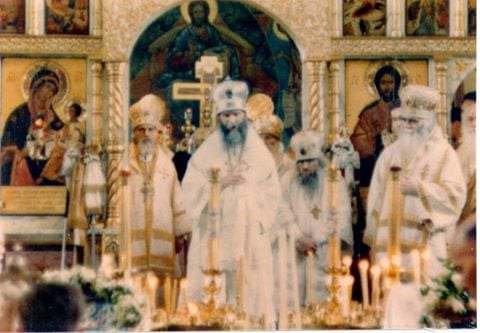
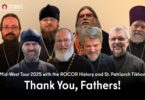
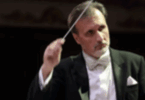

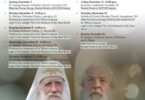
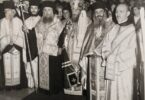
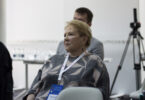


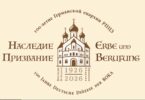
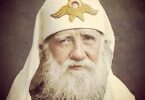
Read here more about the conference: http://www.hts.edu/seminary/news/en/20090604.html
This is a good beginning on a difficult subject. An in-depth study could fill a large volume, and require research into literally tons of paper! There is, of course, today, in the light and warmth of reconciliation, a sort of trend to `forget` many things that happened in the `past.` Until the pertinent archives in Russia are made available, it seems, there can be no `last word` on this subject. Unfortunately, the Moscow Patriarchate itself is standing behind one of the `roadblocks` that do not allow the pertinent archives to be realeased. Such obstructionism always brings only one question: `Why?`
Were the differences between the early christian saints and Nero merely ‘political’? Apart from the obvious that the Roman Emperor was pagan and the early christian saints were not had they wished, the early christian saints could have chosen ‘in those most difficult of times’ to cooperate with Nero, bend a knee to an idol, toss some sand before a statue, and claim something like ‘our hopes are your hopes, our wishes are your wishes’ and thereby preserve themselves from getting tossed out to the lions so that they could survive and go on to do great works for the Church (since at that time they likely were the most gifted and dedicated persons in the new Faith and the Church could have been seen as needing such people to ‘save the Church’). This is not what happened though, the early christian saints suffered martyrdom and became the historical luminaries of the Orthodox Christian Church. History I am sure knows that not all christians went to their martyrdom for the Faith and there may well have been many who did decide to ‘compromise’ or capitulate to Nero (or Lenin, Stalin) and then they could have reasoned that it was the ‘politically correct’ thing to do however maybe not exactly as how the term is understood today though maybe with similarities, nonetheless ‘politically correct’ they may have reasoned so as to live another day and thereby be around to do the ‘work’ of the Church. These christians did not become saints and the Orthodox Church might only say they passed on in history and like everyone eventually to God’s Judgment for only God to judge however the Church is not in communion with these christians, it is in communion with the martyred Saints. In terms of ‘Doctrine’ it may very well have been there was not much difference if any between the one or the other, ‘doctrine’ was not the issue. So was it ‘politics’? No. It was ‘Principal.’ With metropolitan Sergii Stragorodski there was the fundamental breach in principal. Between him and the Tikhonite Russian Orthodox Church communion was severed. The Holy Hieromartyrs ROCOR canonized were excommunicated by him and they likewise broke communion with him. In his lifetime history has no record of his repentance, met. Sergii. So that chapter is done, its closed. The Orthodox Church cannot give confession to those who have passed or like Mormons baptize ancestors who were never baptized. So this is ‘history’ more so than ‘politics’ and its been written. The historical division between the Tichonite Catacomb-ROCOR Church and the MP took place not over what the author here ascertains as ‘political considerations’ however out of Christian Principal.
This is a topic for another discussion since this rationale is not behind the document establishing independent existence of the ROCOR that I cited in my article (See the one of Sept. 1927).
Is your article exclusively only considering “the ‘document’ establishing independent existence of the ROCOR”? Your own title reads: “Looking Toward Unity: How the Russian Church Abroad Viewed the Patriarchate of Moscow, 1927-2007.” Seems the topic is somewhat more broad than that.
I do not know what your interpretation of “this rationale” is when you refer to what I wrote. All the same I will maintain the ‘independent existence of the ROCOR’ is first rooted in Orthodox Principal and thereafter you have the ‘politics’ and the ‘political considerations’ that came about for preservation of that Orthodox Principal. Your writing seems to indicate that only ‘politics’ and ‘political considerations’ were primarily involved in the establishment of ROCOR however the ‘politics’ themselves were not created in a vacuum, there were the things involving the Faith that necessitated the politics.
The points that you made in your initial post (rationale) can be found in Metropolitan Antonii’s and some other bishops’ personal writings, but non in “conciliar pronouncements and other representative documents from the 1920’s.” This rationale has later evolved into the ecclesiology of the Catacomb Church, which I outlined it in the article.
Departure in the “church” is off the charts so they want to change
“sobornost” to “Unyeversalnost” I mean do they think we are so stupid
can’t see that obvious maneuver forwarding papism. Other proposal of the new calendarists bright idea, MP wants to change Holy Spirit to “life quickener” right, we always have to remember the most important rule. All our good deeds are done for Jesus Christ Sake.
The virgins that did not have the right oil or just did not have it they were not allowed in.
The other Virgins had the oil they came in.
[…] Andrei Psarev – ROCOR Studies– […]
Metropolitan Lavr and all the members of our Commission strongly objected to the use of the word “political” in any context as a reason for our separation. The use of the word “political” in the context of the essay is derogatory in the following understanding, “…relating to, affecting, or acting according to the interests of status or authority within an organization rather than matters of principle.” The reason motivating the separation of the Church Abroad from the Moscow Patriarchate and the New Martyrs glorified at the time of our canonization was in fact based not on political consideration but spiritual/ideological principles, closely associated with the understanding of “Sergianism” as meaning collaboration with militant atheists. The mandate given to the Commission to examine those barriers which still existed preventing liturgical concelebration between the churches included a discussion of the proper relationship between Church and State. The main topic in that discussion of concern for us in the Church Abroad were the spiritual consequences of collaboration and our devotion to the memory of the New Martyrs. It was with great difficulty that we were at least able to agree that such a concord was “a mistake”. After returning with the document for perusal by Metropolitan Lavr he expressed the opinion that our conclusions we not satisfactory and that I was to convey at the next commission meeting that the “Declaration” needed to be examined. At that meeting the Commission from the Moscow Patriarchate expressed dismay at the the thought of discussing the topic again and especially the question of the “Declaration”. Many times we also heard from various sources within the Patriarchate that the real reasons for the separation were only “political”. In fact before the meeting where the Declaration was discussed the late Patriarch Alexis gave and interview where he once again claimed the separation was political. Metropolitan Lavr replied, “Tell them when you go again that our motivations were/are not political but spiritual (dukhovnie).
Dear otets Luka,
Thank you very much for taking the time to write this comment for the
sake of the historical record, which illuminates the self-perception
of the members of the ROCOR. We have been writing for decades about
the problems experienced by the church of Russia. I think now we can
disassociate ourselves from our self-perception in order to evaluate
the facts of our history on their own merit.
The beginning of the Russian Church Abroad dates from the civil war
when the country was divided between those who found themselves in
territories controlled by Anti-Bolshevicks forces and those under the
Communist regime. Their experiences in those divided parts were very
different. Many of those who remained in Russia, eventually understood
that the revolutionary regime was there to stay, while many of those
in exile wanted its demolition — at any price.
Isn’t the following list not political? The ROCOR was a church of
stateless political refugees. The council of 1921 passed a resolution
calling for the restoration of the Romanovs. Metropolitan Anthony was
giving blessings to the White terrorists acting in the USSR, constant
appeals of the ROCOR’s hierarchs against supporting a communist regime
in Russia. The first paragraph of the Regulations of the ROCOR
declared that the exiled branch of the Russian Church would exist
independently until the demolition of the godless regime in Russia. So
this anticommunist attitude molded identity of the ROCOR.
I believe your point resonated with the discussion at the First
Pan-Diaspora Council when Metropolitan Anthony was arguing that
monarchism was not politics, but an integral part of the Orthodox
mindset. I beg to disagree. The All-Russia Council of 1917-18
prohibited the proclamation of any political views on behalf of the
church as mandatory and this manifestation at the Russian emigre
council did not do any good for the church in the homeland or
diaspora. In the same way, anticommunist ideology still does not help
us understand Russia or the social and historical causes of the
Russian revolution.
Dear o. Andrei!
I believe that an Orthodox Christian perspective on history needs to consider the spiritual, namely the role of Divine Providence in the movement of historical forces. Even when the Church addresses a matter that might be understood as “civil” or “secular (political?)” it is always from the position of its spiritual understanding of the matter. The Church Abroad in its liturgical life, where the spirituality and teaching of the Church are to a large extent found, always prayed to God to deliver Russia from the “Satanic Power” or the “Godless Authority”. These are not politically motivated expressions but spiritual, and illustrate our Church’s understanding of the Soviet Government. Another illustration was our position towards the New Martyrs where the emphasis was on those who were non-commemorators. The writings of many of these Saints illustrate their understating of the spiritual nature of historical matters, especially in relationship to the Church.